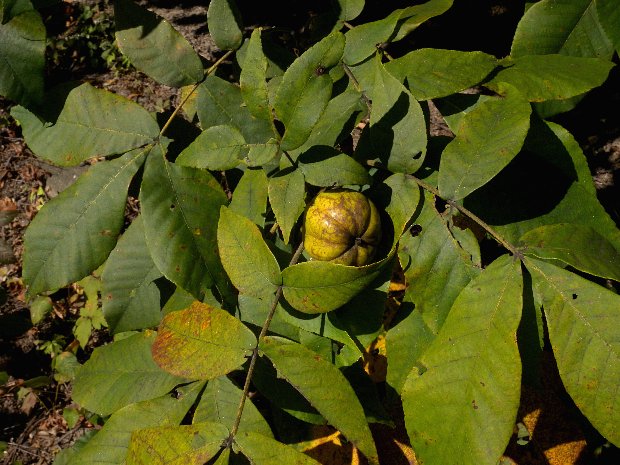
Alternate compound leaves occur along the twigs and shoots. These compound leaves are 9-20" long and odd-pinnate with 7-9 leaflets (rarely 5 leaflets). Individual leaflets are 2½-6" long and 1-2" across; they are lanceolate-elliptic to obovate-elliptic in shape with serrated margins. Leaflet bases are wedge-shaped (cuneate) to rounded, while leaflet tips are tapered and acute. Leaflet upper surfaces are medium green to yellowish green and glabrous to sparsely short-pubescent, while leaflet lower surfaces are pale green and hairy to short-pubescent (at least on the central and lateral veins). Old leaflets during the autumn may become glabrous between the veins. Venation is pinnate with numerous straight lateral veins. The petioles (basal stalks) and rachises (central stalks) of the compound leaves are light green or pale yellowish brown and densely pubescent. The petioles are up to 6" long. The lateral leaflets are sessile or nearly so; their petiolules (basal stalklets) are up to 2 mm. long. The terminal leaflets usually have short petiolules up to 5 mm. long (rarely longer).
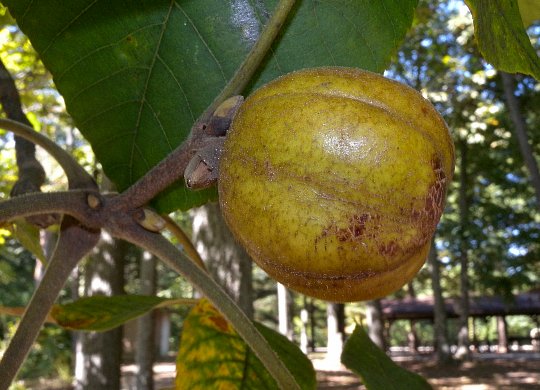
Mockernut Hickory is monoecious, producing separate male (staminate) and female (pistillate) flowers on the same tree. The male flowers are produced in drooping catkins in groups of 3; these greenish catkins are 4-5" long. The rachises (central stalks) of these catkins are hairy. Each male flower (about 3 mm. long) has several short stamens that are partially covered by a hairy 3-lobed bract. The central lobe of each bract is linear in shape and longer than the 2 lateral bracts; the latter are ovate in shape. The inconspicuous female flowers are produced in short spikes at the tips of twigs; each spike has 2-5 female flowers. Each female flower (about 3 mm. long) has an ovoid calyx that is green, pubescent, and 4-toothed along its upper rim; feathery reddish stigmata are exerted from the calyx. The blooming period occurs during late spring for 1-2 weeks. The flowers are cross-pollinated by the wind. Afterwards, the female flowers often abort, although 1-2 of these flowers in some spikes will develop into fruits (nuts with husks) during the summer. At maturity, these fruits are 1½-3" long and a little less across; they are ovoid-globoid or obovoid-globoid in shape, their husks changing in color from light green to yellow to dark brown. The husks are 4-segmented, glabrous to sparsely canescent, and about 6-8 mm. thick. The husks separate along the margins of their segments to at least the middle to release their nuts. Individual nuts are light brown, ovoid-obovoid, slightly flattened (compressed), and somewhat 4-angled; they have thick shells and slightly sweet kernels that are edible. The root system consists of a well-developed taproot with spreading lateral roots.
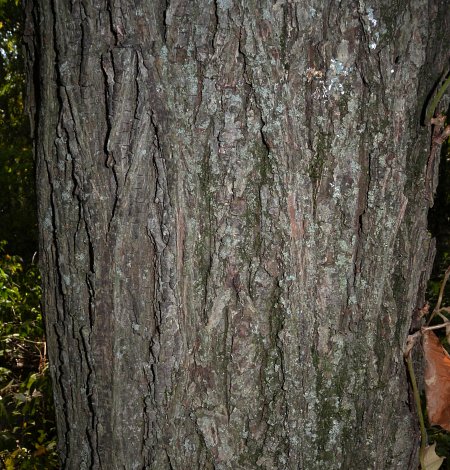
Cultivation: The preference is full or partial sun, moist to dry-mesic conditions, and soil consisting of deep fertile loam. However, this tree adapts to others kinds of soil, including sandy loam and clay-loam. Tree growth is relatively slow. Individual trees begin producing nuts after 25 years and may continue to produce nuts for 200 or more years. This tree resists wind-throw and other kinds of storm damage and it has good tolerance to hot dry conditions. The nuts require a period of cold winter dormancy before they will germinate.
Range & Habitat: The native Mockernut Hickory occurs occasionally in southern and central Illinois, while in the northern section of the state it is rare or absent (see Distribution Map). Illinois lies along the northern range limit of this species. Habitats include rocky hills and wooded slopes, bluffs, upland woodlands,open wooded areas along lakes, and alluvial bottomland woodlands. This tree is more common in upland areas than lowland areas. In Illinois, it is often found in association with other hickories (Carya spp.) and oaks (Quercus spp.). However, outside of the state, it is sometimes found in mixed woodlands of sandy areas where both Pine trees (Pinus spp.) and various deciduous trees are present. Young trees can resprout from their stumps after logging or wildfire.
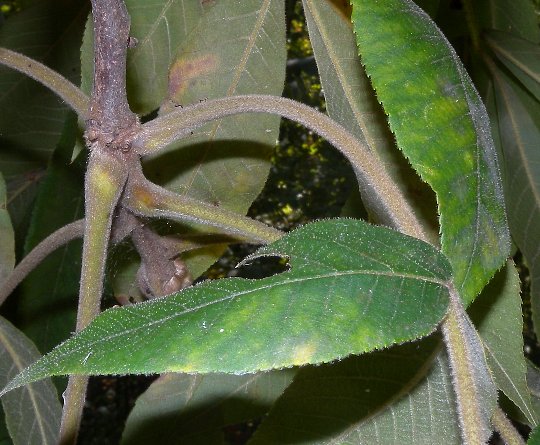
Faunal Associations: Mockernut Hickory and other hickories (Carya spp.) attract a variety of insects that feed on leaves, plant juices, wood, and other parts of these trees. Examples of such insects include the Pecan Spittlebug (Clastoptera achatina), several leafhoppers (primarily Eratoneura spp.), several aphids (Monellia spp., Monelliopsis spp., Protopterocallis spp.), several phylloxerae (Phylloxera spp.), the Hickory Plant Bug (Lygocoris caryae), wood-boring larvae of the Hickory Agrilus (Agrilus otiosus) and Living Hickory Borer (Goes pulcher), larvae of the Hickory Bark Beetle (Scolytus quadrispinosus), nut-boring larvae of the Hickory Curculio (Curculio caryae), larvae of several hickory gall midges (Caryomyia spp.), caterpillars of several Underwing moths (Catocala spp.), and caterpillars of two butterflies, the Banded Hairstreak (Satyrium calanus falacer) and Satyrium caryaevorum (Hickory Hairstreak). Among vertebrate animals, the edible nuts are eaten by the Black Bear, Fox Squirrel, Gray Squirrel, Red Squirrel, Southern Flying Squirrel, Eastern Chipmunk, White-Footed Mouse, Wild Turkey, and Bobwhite Quail. White-Tailed Deer browse on leaves and twigs, while Meadow Voles gnaw on the bark of saplings during the winter. The sap is a source of food for the Yellow-Bellied Sapsucker. The cavities of older trees provide nesting habitat and protection from severe weather for various birds and mammals, including bats.
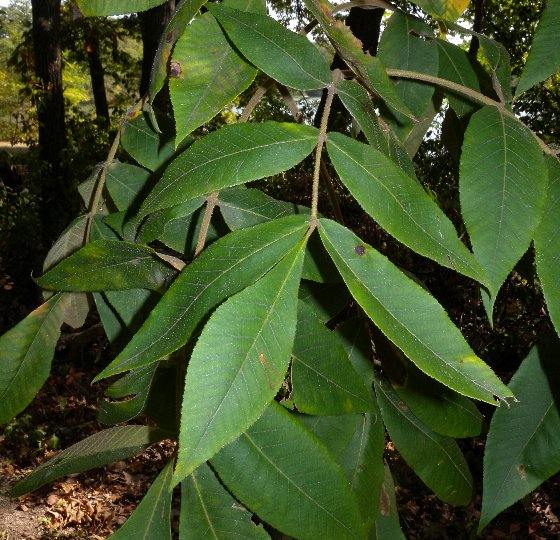
Photographic Location: At a picnic area near a lake at Walnut Point State Park in Douglas County, Illinois.
Comments: The common name of this tree refers to the rather small kernels of its nuts, despite the large size of its fruits. This is the result of the somewhat thick husks of the fruits and the very thick shells of the nuts. The thick shells of these nuts make them difficult to crack open. The Mockernut Hickory (Carya tomentosa) is distinctive among hickory trees (Carya spp.) because of the hairiness of its foliage, especially the young shoots, petioles, and rachises of the compound leaves. Like two species of hickories with shaggy bark, the Shagbark Hickory (Carya ovata) and Shellbark Hickory (Carya laciniata), the Mockernut Hickory has large fruits and it is closely related to them. However, its bark remains relatively tight and does not peel off in strips. The wood of Mockernut Hickory is highly regarded for its hardness and strength. It has been used to make tool handles, agricultural implements, fence posts, baseball bats, and furniture. The wood is used to smoke hams, and it is also considered an excellent fuelwood for the amount of heat that it produces per cord. Another common name of this tree is White Hickory, which refers to the light-colored sapwood.